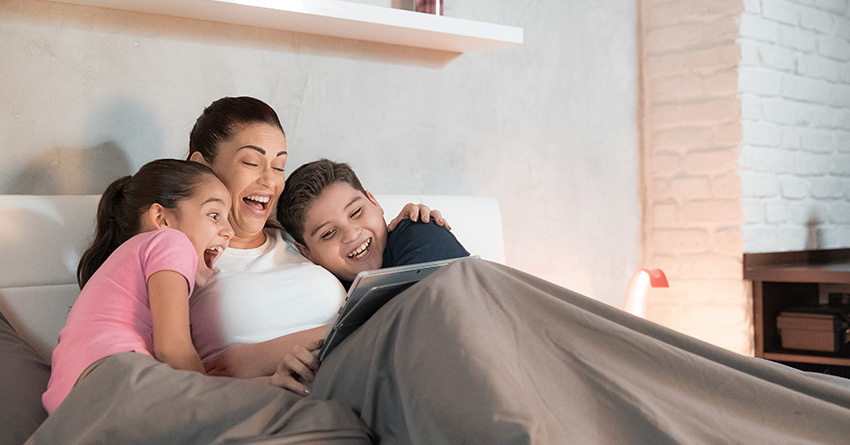Managing screen use for our children can be hard. Luckily, the American Academy of Pediatrics (AAP) has some great recommendations for promoting healthy screen use. They recommend children 18 months and younger to not have exposure to screens other than video-chatting. Children 18-24 months old can start to be introduced to high-quality programs which are educational, such as Daniel Tiger’s Neighborhood and Sesame Street. The parent should engage with the child to help them learn from the program. This means watching the program together and talking with them about what they learned to reinforce the lesson.
Children ages 2-5 can watch a total of 1 hour of high-quality programs per day. Again, it is important to interact with your child to help them understand the concepts and skills from the programs. For children 6 and older, pediatricians recommend no more than 2 hours of screen time per day. Screen use needs to be in moderation and should not interfere with your child’s physical health, sleep, nutrition, and behaviors essential to health.
The AAP has a way for you to create your own family media plan. You can specify when you want your family to use screens and set screen time rules. You can create the exact guidelines you want and hang them in your house. You can also calculate how much screen time you want your child to have through their Media Time Calculator. Check out those resources at https://www.healthychildren.org/English/media/Pages/default.aspx
Implementing these standards from the AAP can be difficult. Here are four tips that can help you and your family manage healthy screen time.
1. Use Parental Control Apps
Parental control apps offer parents the power to control their child’s time on devices. If your child has an iPhone, you can control it through the Screen Time app. Screen Time allows you to monitor their time on the phone, set time limits, and block inappropriate content. You can password protect these features to prevent your child from changing the settings. Here is more information to walk you through how to navigate the Screen Time app. https://www.macrumors.com/how-to/how-to-use-screen-time-in-ios-12/. Android’s parental control app is called Digital Wellbeing. Here is how to use that app. https://www.androidcentral.com/how-use-android-pies-digital-wellbeing-tools
2. Engage with your child
Now that we have limited screen time, our children will want to fill their time with something. This is a great opportunity to strengthen your relationship with them. Spend time doing engaging activities that don’t involve screens. Go on a long walk, play a board game, cook together, or go to the zoo. Let your child pick the activity and focus on having fun together. Use the activity to spend quality time together and focus on strengthening relationships. This helps your child see that good relationships and fun can happen outside of screens.
During these activities, be intentional about having meaningful conversations. Learn about their interests, even if it’s Fortnite. The content of what is discussed is not as important as the connection and bonding that will happen from good conversations. When you talk with your child, try to understand their perspective. Restrict the urge to judge what they are saying and be a good listener. Your goal is to strengthen your relationship with them.
3. Don’t use screens as a pacifier
It’s easy for screens to become a digital pacifier when our kids are upset. Letting them watch one more show keeps them distracted enough for us to finish making dinner or send an email. With the busy schedules we keep, it’s nice to not have to fight with our child when they are watching a screen. But doing that keeps them dependent on devices for comfort. They don’t learn how to self-sooth or be okay with being uncomfortable or bored.
Let your child engage in free play, read a book, or work on a project. Rather than filling time with screens, they can draw, write, or play outside. They could play with their siblings or spend time with you. There are many options in what your child can do to entertain themselves. Even if there is some pushback from your kids, encourage them to do something besides engage with a screen when they are looking for something to do.
4. Model healthy screen usage
At the end of the day, we must practice what we preach. If you make your child turn off the Xbox and talk with you, but you are checking emails during the entire conversation, then you are sending a mixed message. As the parent, you must set a good example of what healthy screen use is. Use your phone or device when it’s appropriate. But, when it’s time to be with family, be with family. Be present in conversations and activities. This lets your family know they are valued. Let’s not be distracted by technology, but model healthy screen use for our kids.
Technology helps us run, but it does not have to run us. We can set the tone of what healthy screen use looks like in our homes. We can have engaging conversations without the distraction of phones. We can use time together to connect rather than being focused on our devices. We can all learn to use screens to enhance our lives rather than distract us from experiencing life. I encourage you to take a step to improve the health of your child’s screen time today.
For more information from the AAP, check out this article. https://www.aap.org/en-us/about-the-aap/aap-press-room/news-features-and-safety-tips/Pages/Children-and-Media-Tips.aspx
Jeremy Edge is a licensed professional counselor and the owner of ESCAPINGTHE.COM, PLLC. He provides counseling services for those struggling with Internet addictions and screen-related problems. Visit his website at www.escapingthe.com for more information and resources about problematic Internet use and how to get help.




